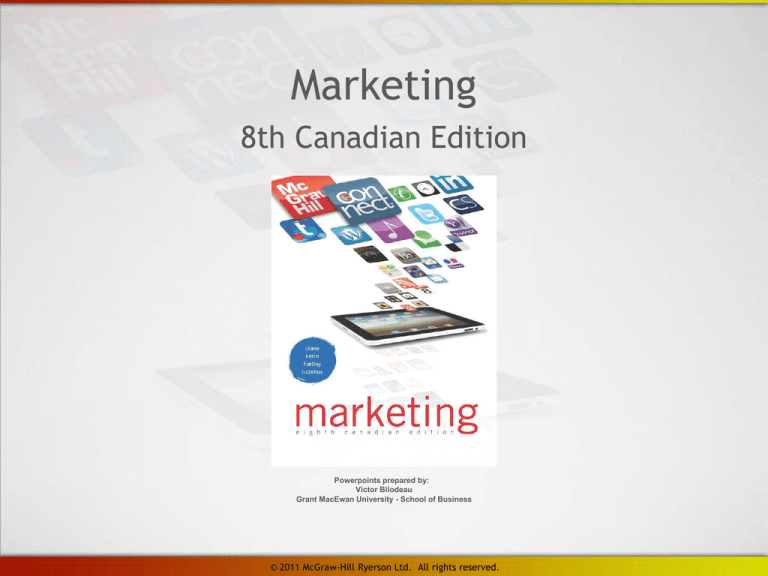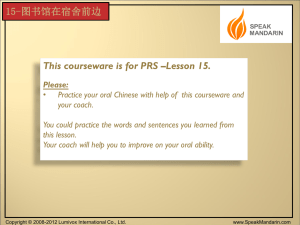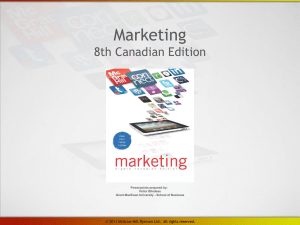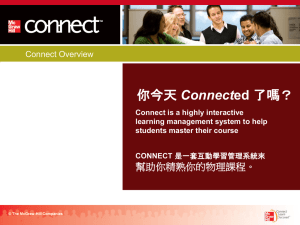
Marketing
8th Canadian Edition
Powerpoints prepared by:
Victor Bilodeau
Grant MacEwan University - School of Business
© 2011 McGraw-Hill Ryerson Ltd. All rights reserved.
Developing New
Products and Services
© 2011 McGraw-Hill Ryerson Ltd. All rights reserved.
Learning Objectives
After reading this chapter and engaging with this lecture, you should be able to:
1.Recognize the various terms that pertain to products and
services.
2.Identify the ways in which consumer and business goods and
services can be classified.
3.Explain the implications of alternative ways of viewing “newness”
in new products and services.
4.Describe the factors contributing to a product’s or service’s
failure.
5.Explain the purposes of each step of the new-product process.
© 2011 McGraw-Hill Ryerson Ltd. All rights reserved.
© 2011 McGraw-Hill Ryerson Ltd. All rights reserved.
Apple’s New-Product Innovation Machine
‣ Steve Jobs, co-founder and CEO of Apple, Inc.
‣ Apple Inc. is rated by Business Week as one of the
most innovative companies on the globe.
‣ Innovative products such as the MacBook Air, iTunes,
iPhone, iPod nano, iPod Touch and the iPad.
‣ Within just 80 days of its release, Apple sold over 80
million iPad units.
‣ The iPad will run almost all of the more than 225,000
apps on the App Store, including apps already
purchased for your iPhone.
© 2011 McGraw-Hill Ryerson Ltd. All rights reserved.
THE VARIATIONS OF PRODUCTS
‣ Product Item, Product Line and Product Mix
‣ Classifying Products
‣ Type of User
‣ Consumer goods
‣ Business goods
‣ Degree of Tangibility
‣
‣
‣
‣
Non-durable good
Durable good
Service
Experience
© 2011 McGraw-Hill Ryerson Ltd. All rights reserved.
LO 1
CLASSIFYING CONSUMER
AND BUSINESS GOODS
‣ Classification of Consumer Goods
‣ Convenience goods
‣ Shopping goods
‣ Specialty goods
‣ Unsought goods
‣ What would be an example of an unsought good
© 2011 McGraw-Hill Ryerson Ltd. All rights reserved.
LO 2
FIGURE 10-1 Classification of consumer goods
© 2011 McGraw-Hill Ryerson Ltd. All rights reserved.
LO 2
CLASSIFYING CONSUMER
AND BUSINESS GOODS
‣ Classification of Business Goods
‣ Production Goods
‣ Support Goods
‣
‣
‣
‣
Installations
Accessory Equipment
Supplies
Services
© 2011 McGraw-Hill Ryerson Ltd. All rights reserved.
LO 2
WHAT IS A NEW PRODUCT?
‣ Newness Compared with Existing Products
‣ Newness in Legal Terms
‣ Newness from the Company’s Perspective
‣ Newness from the Consumer’s Perspective
© 2011 McGraw-Hill Ryerson Ltd. All rights reserved.
LO 3
FIGURE 10-2 Consumption effects define newness
© 2011 McGraw-Hill Ryerson Ltd. All rights reserved.
LO 3
For how the kind of
innovation
present in this
ketchup bottle
and the innovation
present in the
Amazon Kindle
affects marketing
strategy, see the
text.
© 2011 McGraw-Hill Ryerson Ltd. All rights reserved.
LO 3
WHAT ARE NEW SERVICES?
‣ Major service innovations
‣ Major process innovations
‣ Service-line extensions
‣ Process-line extensions
‣ Supplementary-service innovations
‣ Basic service improvements
‣ Style changes
© 2011 McGraw-Hill Ryerson Ltd. All rights reserved.
LO 3
WHY NEW PRODUCTS OR SERVICES
SUCCEED OR FAIL
‣ Marketing Reasons for New-Product Failures
‣ Insignificant “point of difference”
‣ Incomplete market and product definition (Protocol)
‣ Too little market attractiveness
‣ Poor execution of the marketing mix
‣ Poor product quality on critical factors
‣ Bad timing
‣ No economical access to buyers
© 2011 McGraw-Hill Ryerson Ltd. All rights reserved.
LO 4
FIGURE 10-3 Why did these new products fail?
© 2011 McGraw-Hill Ryerson Ltd. All rights reserved.
LO 4
WHY NEW PRODUCTS OR SERVICES
SUCCEED OR FAIL
‣ A Look at Some Failures
‣ What were they thinking? Organizational problems newproduct failure.
‣ Not really listening to the “voice of the consumer.”
‣ Skipping steps in the new-product process.
‣ Pushing a poorly conceived product into the market to generate
quick revenue.
‣ “Groupthink” in task force and committee meetings.
‣ Not learning critical takeaway lessons from past failures.
‣ How Marketing Dashboards Can Reduce New-Product
Failures
© 2011 McGraw-Hill Ryerson Ltd. All rights reserved.
LO 4
FIGURE 10-4 Stages in the new-product process
© 2011 McGraw-Hill Ryerson Ltd. All rights reserved.
LO 5
THE NEW-PRODUCT PROCESS
‣ Stage 1: New-Product Strategy Development
‣ Objectives of the Stage: Identify Markets and Strategic Roles
‣ Cross-Functional Teams
‣ Lead Users
© 2011 McGraw-Hill Ryerson Ltd. All rights reserved.
LO 5
THE NEW-PRODUCT PROCESS
‣ Stage 2: Idea Generation
‣ Customer and Supplier Suggestions
‣ Employee and Co-Worker Suggestions
‣ Research and Development Breakthroughs
‣ Competitive Products
‣ Universities, Inventors, and Small Technology Firms
© 2011 McGraw-Hill Ryerson Ltd. All rights reserved.
LO 5
THE NEW-PRODUCT PROCESS
‣ Stage 3: Screening and Evaluation
‣ Internal Approach
‣ External Approach
‣ Concept Tests
© 2011 McGraw-Hill Ryerson Ltd. All rights reserved.
LO 5
3M’s new Post-it®
Flag Highlighter
© 2011 McGraw-Hill Ryerson Ltd. All rights reserved.
LO 5
The use of online concept tests: an external evaluation
method for new product ideas
© 2011 McGraw-Hill Ryerson Ltd. All rights reserved.
LO 5
THE NEW-PRODUCT PROCESS
‣ Stage 4: Business Analysis
‣ Stage 5: Development
‣ Stage 6: Market Testing
‣ Test Marketing
‣ Simulated Test Markets
‣ Virtual Reality Market Testing
‣ When Test Markets Do Not Work
© 2011 McGraw-Hill Ryerson Ltd. All rights reserved.
LO 5
Mattel’s Barbie
During development, laboratory tests like this one result in safer dolls
for toys for children
© 2011 McGraw-Hill Ryerson Ltd. All rights reserved.
LO 5
THE NEW-PRODUCT PROCESS
‣ Stage 7: Commercialization
‣ Slotting fee
‣ Failure fee
© 2011 McGraw-Hill Ryerson Ltd. All rights reserved.
FIGURE 10-5 Marketing information and methods used in the
new-product process
© 2011 McGraw-Hill Ryerson Ltd. All rights reserved.
LO 5
VIDEO CASE 10
3M™ Greptile Grip™ Golf Glove: Great Gripping!
© 2011 McGraw-Hill Ryerson Ltd. All rights reserved.
VIDEO CASE 10
3M™ Greptile Grip™ Golf Glove: Great Gripping!
3M Greptile
© 2011 McGraw-Hill Ryerson Ltd. All rights reserved.
VIDEO CASE 10-1
3M™ Greptile Grip™ Golf Glove: Great Gripping!
What are the characteristics of the target market for
the 3M Greptile Grip golf glove?
© 2011 McGraw-Hill Ryerson Ltd. All rights reserved.
VIDEO CASE 10-2
3M™ Greptile Grip™ Golf Glove: Great Gripping!
What are the key points of difference of the 3M
Greptile Grip golf glove when compared with
competitors’ products, such as FootJoy and Nike?
Substitute products, such as golf grips?
© 2011 McGraw-Hill Ryerson Ltd. All rights reserved.
VIDEO CASE 10-3
3M™ Greptile Grip™ Golf Glove: Great Gripping!
How does the Greptile Grip golf glove meet 3M’s three
criteria for new products?
© 2011 McGraw-Hill Ryerson Ltd. All rights reserved.
VIDEO CASE 10-4
3M™ Greptile Grip™ Golf Glove: Great Gripping!
Because 3M has no prior products for the golf market,
what special promotion and distribution problems
might 3M have?
© 2011 McGraw-Hill Ryerson Ltd. All rights reserved.
VIDEO CASE 10-5
3M™ Greptile Grip™ Golf Glove: Great Gripping!
What would be some new markets and new
applications of the greptile grip technology that 3M
could pursue?
© 2011 McGraw-Hill Ryerson Ltd. All rights reserved.
Product
‣ A good, service, or idea consisting of a bundle of
tangible and intangible attributes that satisfies
consumers and is received in exchanges for money or
some other unit of value.
© 2011 McGraw-Hill Ryerson Ltd. All rights reserved.
Product Line
‣ A group of products that are closely related because
they satisfy a class of needs, are used together, are
sold to the same customer group, are distributed
through the same outlets, or fall within a given price
range.
© 2011 McGraw-Hill Ryerson Ltd. All rights reserved.
Consumer Goods
‣ Products purchased by the ultimate consumer.
© 2011 McGraw-Hill Ryerson Ltd. All rights reserved.
Business Goods
‣ Products that assist directly or indirectly in providing
products for resale.
© 2011 McGraw-Hill Ryerson Ltd. All rights reserved.
Convenience Goods
‣ Items that the consumer purchases frequently and
with a minimum of shopping effort.
© 2011 McGraw-Hill Ryerson Ltd. All rights reserved.
Shopping Goods
‣ Items for which the consumer compares several
alternatives on criteria such as price, quality, or
style.
© 2011 McGraw-Hill Ryerson Ltd. All rights reserved.
Specialty Goods
‣ Items that a consumer makes a special effort to
search out and buy.
© 2011 McGraw-Hill Ryerson Ltd. All rights reserved.
Unsought Goods
‣ Items that the consumer either does not know about
or knows about but does not initially want.
© 2011 McGraw-Hill Ryerson Ltd. All rights reserved.
Production Goods
‣ Items used in the manufacturing process that become
part of the final product.
© 2011 McGraw-Hill Ryerson Ltd. All rights reserved.
Support Goods
‣ Items used to assist in producing other goods and
services.
© 2011 McGraw-Hill Ryerson Ltd. All rights reserved.
Protocol
‣ A statement that, before product development
begins, identifies (1) a well-defined target market; (2)
specific customer’ needs, wants, and preferences; an
(3) what the product will do.
© 2011 McGraw-Hill Ryerson Ltd. All rights reserved.
New-Product Process
‣ The sequence of activities a firm uses to identify
business opportunities and convert them to a saleable
good or service.
© 2011 McGraw-Hill Ryerson Ltd. All rights reserved.
New-Product
Strategy Development
‣ Defining the role for a new product in terms of the
firm’s overall corporate objectives.
© 2011 McGraw-Hill Ryerson Ltd. All rights reserved.
Six Sigma
‣ A means to “delight the customer” by achieving
quality through a highly disciplined process to focus
on developing and delivering near-perfect products
and services.
© 2011 McGraw-Hill Ryerson Ltd. All rights reserved.
Idea Generation
‣ Developing a pool of concepts as candidates for new
products.
© 2011 McGraw-Hill Ryerson Ltd. All rights reserved.
Screening and Evaluation
‣ The third stage of the new product process which
involves internal and external evaluations of the newproduct ideas to eliminate those that warrant no
further effort.
© 2011 McGraw-Hill Ryerson Ltd. All rights reserved.
Business Analysis
‣ Involves specifying the features of the product and
the marketing strategy needed to commercialize it
and making necessary financial projections.
© 2011 McGraw-Hill Ryerson Ltd. All rights reserved.
Development
‣ Turning the idea on paper into a prototype.
© 2011 McGraw-Hill Ryerson Ltd. All rights reserved.
Market Testing
‣ Exposing actual products to prospective consumers
under realistic purchase conditions to see if they will
buy.
© 2011 McGraw-Hill Ryerson Ltd. All rights reserved.
Commercialization
‣ Positioning and launching a new product in full-scale
production and sales.
© 2011 McGraw-Hill Ryerson Ltd. All rights reserved.
Slotting Fee
‣ Payment manufacturer makes to place a new item on
a retailer’s shelf.
© 2011 McGraw-Hill Ryerson Ltd. All rights reserved.
Failure Fee
‣ A penalty payment made by a manufacturer to
compensate the retailer for sales its valuable shelf
space never made.
© 2011 McGraw-Hill Ryerson Ltd. All rights reserved.
Product Mix
‣ The number of product lines offered by a company.
© 2011 McGraw-Hill Ryerson Ltd. All rights reserved.










